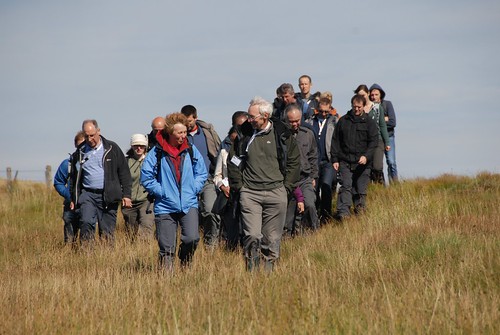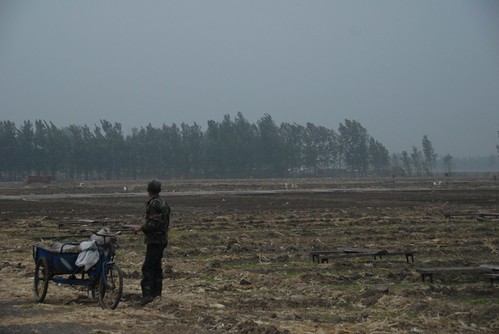Congratulations to my PhD student Will who successfully defended his thesis on phosphorus bio-geochemistry today! Well done Will!
Thursday, 24 October 2013
Friday, 18 October 2013
On wheat-maize rotations and nutrient flows in Huantai County, Shandong Province, 14th-16th October 2013
This visit was separated into four parts. Firstly, we met farmers and growers at a local village that was closely connected to an experimental station. We also met an agricultural entrepreneur who ran a corn and wheat processing company, and then we visit the institute itself and met officials from the Huantai Agricultural Bureau. Finally, when we were in Beijing on 16th we visited the west campus of the China Agriculture University (CAU) and spoke with Professors Wu and Meng, who were the academic leaders of the experiments. We were shown a useful presentation by Wu Lingfen who is an MSc student doing an N balance for Huantai County 1980-2012. Huantai county claims to be the most productive county in China (this seems to be a legitimate claim) and we were shown a film that promoted it in an extremely positive and production centric light, although there were some references to ‘mitigating’ non point source pollution that did not match with our analysis of things when we interviewed people. The rotations seem to plough in the straw stubble and consequently the soil organic matter is seemingly not declining and there are claims for it to have been actually increasing.
A few key learning outcomes for me were:
•The nitrate levels in the groundwater seemed to be approximately 3x the UK standard
•The water flows in this region are almost all to groundwater, so there is a sense of ‘out of sight, out of mind’.
•There was little real regard or concern for water quality
•According to the Agricultural Bureau, the water quality monitoring is the ‘job for the provisional government’ and that the information is ‘classified’. The bureau did not seem to be aware of any county level programme for protecting water resources.
•Generally there seems to be a nitrogen centric view here, phosphorus was little mentioned although it is used with N and K (in a bagged fertilizer NPK 15-15-15)
My photos from the trip to Huantai can be viewed here.
Phil
A few key learning outcomes for me were:
•The nitrate levels in the groundwater seemed to be approximately 3x the UK standard
•The water flows in this region are almost all to groundwater, so there is a sense of ‘out of sight, out of mind’.
•There was little real regard or concern for water quality
•According to the Agricultural Bureau, the water quality monitoring is the ‘job for the provisional government’ and that the information is ‘classified’. The bureau did not seem to be aware of any county level programme for protecting water resources.
•Generally there seems to be a nitrogen centric view here, phosphorus was little mentioned although it is used with N and K (in a bagged fertilizer NPK 15-15-15)
My photos from the trip to Huantai can be viewed here.
Phil
Monday, 14 October 2013
On Rice and Wheat rotations, nutrient management, and Lake Taihu in Jiangsu Province….
We have just spent the last 2 days in the vicinity of Suzhoe and Wuxi in the Lake Taihu catchment in Jaingsu Province. We were visiting as part of the Defra SAIN (Strategic Agriculture Innovation Network) collaboration between the UK and China Governments. Our aim was to visit local rice-wheat rotations with a view to learning about how the agricultural systems ‘worked’ and in particular focusing on the nutrient management. On Friday 11th October 2013 we visited Xingeng Village, to the Northeast of Wangting Town. On the following day we visited a Demonstration site west of Wuxi, the Sandongqiao Village Demonstration Site. On the 11th, firstly were shown some mature rice that was due for harvest later in the autumn. Of course rice production involves flooding the field and that happens earlier in the year. I understand there is a top dressing of fertilizer input at time of sowing, and that this is applied when the padi is flooded. This is intriguing as there is potentially considerable potential for direct nutrient transfers to water at times of flooding. There is also potential for groundwater transfers through potentially cracking clay soil. Additionally, as there is the potential in this extreme wetting and drying to drive nutrient cycling and accelerate nutrient mobilization from soil in these circumstances – it would be interesting to investigate this hypothesis. I would be interested to see how much nutrient was lost in detached soil or sediment around times of sowing when the crop is immature. We asked questions of the team about the nutrient management and as far as we could understand they seemed to have a very agronomic centric view, inasmuch as they spoke of monitoring the system wholly in terms of fertilizer and recycled manure inputs. When questioned about transfers to water they did not seem to have a sense of the potential kg/ha losses, nor any sense of the hydrologic dynamics. There was not any evidence of measuring water flow so therefore I cannot see how they have any sense of nutrient flows to water. On the Saturday at Sandongqiao we met the impressive Prof Yudong Li (Shanghai Jiantong University) who appeared to have a much greater sense of the importance of flows to water. However, the Sandongqiao site is only in its infancy and although the rotation has the potential to offer some useful data in the future.
In summary:
•There are no data on flows to water and there seems to be a lack of emphasis on this
•The systems appear to be constrained and driven by agronomic production with only an emerging regard for losses to the environment
•It reminds me of my own work in the UK in the early 1990s, with systems driven by soil P tests and fertilizer levels, occasional concentration in water. The next step is that they need to learn to determine the nature of the losses to the water, including the hydrological flows and dynamics, not just the concentrations in water.
•A great ‘problem’ for these systems is the density of the population; therefore one cannot manage the water quality without a sense of the agriculture combined with the human inputs. There are governance and communication challenges here
•The work at Sandongqiao is promising and I see analogies with other studies in the past.
My photos from this trip can be viewed here.
Phil
In summary:
•There are no data on flows to water and there seems to be a lack of emphasis on this
•The systems appear to be constrained and driven by agronomic production with only an emerging regard for losses to the environment
•It reminds me of my own work in the UK in the early 1990s, with systems driven by soil P tests and fertilizer levels, occasional concentration in water. The next step is that they need to learn to determine the nature of the losses to the water, including the hydrological flows and dynamics, not just the concentrations in water.
•A great ‘problem’ for these systems is the density of the population; therefore one cannot manage the water quality without a sense of the agriculture combined with the human inputs. There are governance and communication challenges here
•The work at Sandongqiao is promising and I see analogies with other studies in the past.
My photos from this trip can be viewed here.
Phil
Tuesday, 1 October 2013
Caption competition!
We have been having a bit of fun trying to think up cations for this photo of John and Ed.
e.g 1:
I think we were deciding to move Haygarth to play wide on the left, with Allton as the lone striker.
e,g. 2:
Ed (thought bubble) ‘I wish he’d stop going on about soil erosion’
Any suggestions welcome.....
e.g 1:
I think we were deciding to move Haygarth to play wide on the left, with Allton as the lone striker.
e,g. 2:
Ed (thought bubble) ‘I wish he’d stop going on about soil erosion’
Any suggestions welcome.....
Soil Scientists footloose in the north Pennines!

Recently working with my colleagues in the British Society of Soil Science, we hosted the annual conference based at Lancaster but had a field trip in the Eden Valley and on Hartside. The weather was terrific. Thanks to all the team for a great effort - here are the photos that I took on the day
Subscribe to:
Comments (Atom)



